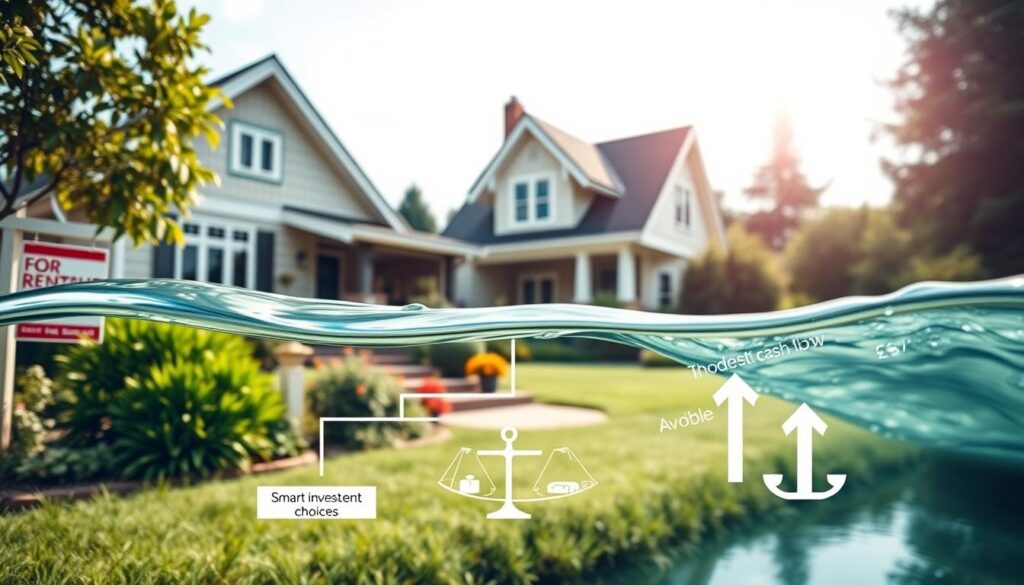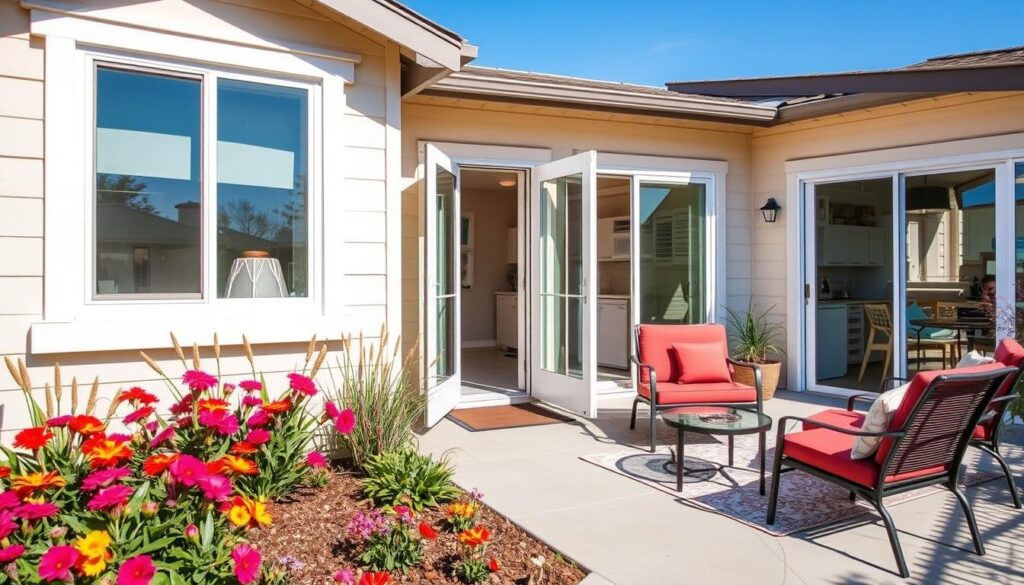Cash flow in real estate is the difference between a property’s rental income and operating expenses, including the mortgage payment. Maintaining positive cash flow is crucial for long-term success in property investing, as it ensures rental property cash flow remains stable and investment property profitability increases. A positive cash flow from a rental property occurs when the rental income covers all expenses, resulting in profit for the investor.
According to Zillow, the typical home value of a middle-price tier home in the U.S. saw an 18.4% increase last year, with a forecasted 13.6% appreciation over the next year. This trend highlights the potential for rental property cash flow to turn positive, even for properties with initial negative cash flow, through strategic investment and patience.
Table of Contents
Key Takeaways
- Positive cash flow is essential for long-term success in rental property investing.
- Rental property cash flow can be affected by various factors, including rental income, operating expenses, and mortgage payments.
- Investment property profitability relies on maintaining a stable and positive cash flow.
- Strategic investment and patience can help turn negative cash flow into positive cash flow.
- Careful forecasting and accounting for costs are necessary for accurate cash flow calculations.
- Achieving positive cash flow may take more than one or two years, especially with extensive renovations and higher expense growth projections.
Understanding Rental Property Cash Flow Basics
Rental property cash flow is a crucial aspect of real estate investing, as it determines the profitability of a property. There are three types of cash flow: positive, break-even, and negative. Positive cash flow occurs when rental income exceeds expenses, while break-even cash flow is when income equals expenses, and negative cash flow is when expenses exceed income.
To achieve a positive cash flow, it’s essential to understand the key factors that affect rental income. These include the property’s location, size, and condition, as well as the local rental market. A well-managed property with a competitive rental rate can generate a steady rental income stream, which is vital for maintaining a positive cash flow.
Common causes of negative cash flow include high operating expenses, vacancies, and poor property management. To avoid this, investors should conduct thorough research and analysis before purchasing a property, considering factors such as break-even cash flow and potential rental income. By understanding these basics, investors can make informed decisions and increase their chances of achieving a positive cash flow from their rental property.
Key factors affecting rental property income
- Location and local market conditions
- Property size, condition, and amenities
- Rental rate and lease terms
- Property management and maintenance costs
Common causes of negative cash flow
- High operating expenses
- Vacancies and rental income loss
- Poor property management
- Insufficient rental income to cover expenses
Conducting Thorough Pre-Purchase Analysis
Before investing in a rental property, it’s essential to conduct a thorough property analysis to determine its potential for generating positive cash flow. This involves assessing local market conditions, estimating potential rental income, and calculating all associated costs. A comprehensive investment due diligence process can help investors make informed decisions and avoid properties prone to negative cash flow.
Some key factors to consider during the pre-purchase analysis include:
- Local market trends and rental demand
- Property condition and potential for renovation or improvement
- Financing options and associated costs
- Operating expenses, including property taxes, insurance, and maintenance
By carefully evaluating these factors and conducting thorough property analysis and investment due diligence, investors can minimize the risk of negative cash flow and ensure a successful rental property investment.
| Factor | Considerations |
|---|---|
| Local Market Trends | Rental demand, vacancy rates, and average rent prices |
| Property Condition | Age, condition, and potential for renovation or improvement |
| Financing Options | Interest rates, loan terms, and associated costs |
How to Calculate Potential Rental Income Accurately
To determine the potential rental income of a property, it’s essential to conduct a thorough market rent analysis. This involves researching the rental rates of similar properties in the area to establish a fair market rent. Resources like Rentometer or Zillow Rent Zestimate can provide valuable insights into the local rental market.
A key factor in rental income calculation is understanding the concept of Gross Scheduled Rental Income (GSR) and Effective Gross Income (EGI). GSR is the total rent charged for the property, while EGI takes into account vacancies and credit losses to provide a more accurate representation of the actual income generated by the property. By considering these factors, investors can make informed decisions about their rental property investments.
When calculating potential rental income, it’s crucial to consider seasonal fluctuations in rental demand and vacancy rates. A thorough market rent analysis will help investors determine the optimal rental rate for their property, ensuring a positive cash flow. By following these steps, investors can accurately calculate their potential rental income and make informed decisions about their investment portfolio.
| Term | Definition |
|---|---|
| Gross Scheduled Rental Income (GSR) | Total rent charged for the property |
| Effective Gross Income (EGI) | Actual income generated by the property, considering vacancies and credit losses |
| Market Rent Analysis | Researching rental rates of similar properties in the area to establish a fair market rent |
By understanding these key concepts and conducting a thorough market rent analysis, investors can ensure a positive cash flow from their rental properties and achieve their investment goals.
Essential Steps to Avoid Negative Cash Flow from Rental Properties
Investing in rental properties can be a lucrative venture, but it requires careful planning and management to avoid negative cash flow. Negative cash flow occurs when the rental income is not enough to cover the expenses and debt service, resulting in a loss for the investor. To avoid this, investors can implement cash flow improvement strategies such as adjusting rent to fair market prices, improving tenant screening, reducing operating expenses, and updating the property to justify higher rent.
Effective rental property management is crucial to maintaining a positive cash flow. This includes regularly reviewing and adjusting the rental price, ensuring timely rent payments, and minimizing vacancies. By taking a proactive approach to property management, investors can reduce the risk of negative cash flow and ensure a steady income stream.
Some key strategies to avoid negative cash flow include:
- Conducting thorough market research to determine fair rental prices
- Implementing a rigorous tenant screening process to minimize vacancies and reduce the risk of non-payment
- Regularly reviewing and adjusting operating expenses to ensure they are in line with budget
- Considering strategic property upgrades to increase rental income and justify higher rent
By following these essential steps and implementing effective cash flow improvement strategies and rental property management techniques, investors can minimize the risk of negative cash flow and ensure a successful and profitable rental property investment.
| Strategy | Description |
|---|---|
| Cash Flow Improvement | Implementing strategies to increase rental income and reduce expenses |
| Rental Property Management | Effectively managing the rental property to minimize vacancies and reduce operating expenses |
Setting the Right Rental Price Strategy
To maximize rental income, it’s crucial to set the right rental price. This involves rental price optimization and understanding the local market through competitive rent analysis. By analyzing comparable properties, landlords can determine the optimal rental rate for their property.
Before renewing a tenant’s lease, an investor can run rent comparables to determine the current fair market rent for similar homes. This helps in making informed decisions about rental pricing. Considerations such as location, amenities, and the time of year can impact rental rates, with properties near desirable amenities generally fetching higher rates.
Some key factors to consider when setting rental prices include:
- Seasonal demand, with higher demand in summer months potentially leading to higher rental rates
- Property upgrades and amenities, such as new appliances or central air, which can attract quality renters
- Pet policies, as allowing pets can widen the potential tenant pool but may require additional fees or deposits
By balancing profitability with setting a fair rental rate, landlords can attract tenants who will take care of the property, reducing maintenance costs and increasing long-term profits. Regularly reviewing and adjusting rental prices based on market conditions and competitive rent analysis is essential for maintaining a positive cash flow.
| Factor | Impact on Rental Price |
|---|---|
| Location | Properties near amenities fetch higher rates |
| Seasonal Demand | Higher demand in summer months can lead to higher rates |
| Property Upgrades | Upgrades like new appliances can attract quality renters and increase rates |
Minimizing Property Maintenance Costs
Regular property upkeep is essential to prevent minor issues from becoming major problems. By investing in cost-effective maintenance, property owners can avoid costly repairs and reduce the financial burden of maintenance. This approach involves regular inspections, timely repairs, and a proactive maintenance schedule.
A well-maintained property not only reduces maintenance costs but also attracts reliable tenants and increases the property’s value. Some strategies for minimizing property maintenance costs include:
- Regular property inspections to identify potential issues
- Implementing a maintenance schedule to stay on track
- Addressing small repairs immediately to prevent larger problems
- Monitoring appliance performance and replacing them with energy-efficient models when necessary
By prioritizing cost-effective maintenance and property upkeep, investors can improve their property’s cash flow position and reduce the risk of unexpected expenses. As a result, they can enjoy a more stable and profitable investment.
Effective maintenance is crucial to maintaining a positive cash flow. By being proactive and investing in regular property upkeep, property owners can minimize costs and maximize their returns.
Effective Tenant Screening Processes
Implementing a thorough tenant screening process is crucial for landlords to minimize the risk of rental payment issues and property damage. A well-structured rental application process can help landlords select reliable and trustworthy tenants. By using online tenant screening services, landlords can pull credit reports, rental histories, and background checks to better qualify applicants.
Some key factors to consider in the tenant screening process include:
- Background check essentials, such as credit score and criminal history
- Income verification methods, such as pay stubs and employment verification
- Reference checking procedures, such as contacting previous landlords and employers
By following a thorough tenant screening process, landlords can reduce the likelihood of rental evictions and property damage, ensuring a consistent revenue stream and long-term value of their assets.
| Benefits of Tenant Screening | Description |
|---|---|
| Reduced risk of rental payment issues | Thorough screening helps landlords select reliable tenants |
| Minimized property damage | Screening helps landlords identify potential tenants who are trustworthy and responsible |
Managing Operating Expenses Efficiently
Effective expense management is crucial for maintaining a positive cash flow from rental properties. Operating expenses that consistently run over budget can lead to negative cash flow, making it essential to create and stick to a budget. Identifying areas for cost reduction strategies is also vital, as it can help investors improve their property’s overall cash flow performance.
Some key areas to focus on include property maintenance, utility bills, and property management fees. By allocating 1% to 3% of the property’s value per year for maintenance and repairs, investors can avoid unexpected expenses. Additionally, assuming a 10% vacancy rate for rental property budgeting can help mitigate the impact of vacant periods on cash flow.
To implement effective cost reduction strategies, investors can consider the following:
- Prioritizing tenant retention to reduce turnover rates and related expenses
- Developing positive relationships with contractors, accountants, property managers, and tenants for smoother communication during financial challenges
- Conducting comprehensive tenant screenings to secure reliable and suitable tenants
By implementing these strategies, investors can efficiently manage their operating expenses, reduce costs, and improve their property’s cash flow performance. Effective expense management and cost reduction strategies are essential for maintaining a positive cash flow and achieving long-term success in the rental property industry.
Strategic Property Upgrades for Better Returns
Investors can increase their rental income and attract qualified tenants by making strategic property upgrades. This can include high-ROI improvements, cost-effective renovations, and energy efficiency investments. By making smart upgrades, investors can justify higher rents and attract quality tenants, positively impacting cash flow.
Some key renovations that can significantly impact tenant satisfaction and rental income include enhancing curb appeal, kitchen, and bathroom improvements. Cosmetic updates, like repainting walls or updating fixtures, offer a cost-effective way to enhance property appeal without extensive renovations. Energy-efficient upgrades, such as solar panels and LED lighting, can lead to reduced expenses and attract eco-conscious tenants.
Understanding ROI through careful cost-benefit analysis before major renovations is crucial for maximizing returns and evaluating rental property performance. Strategic renovations based on accurate ROI calculations and market data can boost property value, tenant satisfaction, and overall profitability. Some popular upgrades include:
- Integrating smart home technology, such as programmable thermostats and security devices
- Installing energy-efficient windows and LED lighting
- Implementing sustainable landscaping and energy-efficient appliances
By investing in these property upgrades and rental property improvements, investors can increase their chances of attracting qualified tenants and achieving a positive cash flow. Regular maintenance and effective management of vacancy rates are also essential for sustaining net cash flow and overall profitability.
| Upgrade Type | ROI Range | Impact on Cash Flow |
|---|---|---|
| Energy-efficient upgrades | 10-15% | Reduced expenses, increased rental income |
| Cosmetic updates | 5-10% | Increased property appeal, higher rental rates |
| Smart home technology | 8-12% | Increased property value, attract tech-savvy tenants |
Creating Emergency Funds and Reserves
As a landlord, it’s essential to have a financial safety net to weather unexpected expenses and maintain positive cash flow. Rental property reserves can help you cover large, upfront costs such as deductibles for disasters, appliance replacements, and repairs. A common rule of thumb suggests maintaining 3-6 months of expenses in an emergency fund for rental properties.
A safe emergency fund for a rental property would be around $8,136, based on a total monthly expenses of $1,356. This amount can be determined by considering factors such as vacancy history, turnover rates, and the age of the property. Financial planning for landlords should include setting aside a portion of the annual rent collected, typically between 20%-40%, or having a number of months’ worth of rent in reserve, generally between 3-6 months.
It’s crucial to be conservative with the reserve amount due to rising costs of materials and labor for maintenance and repairs. If an investor cannot afford to establish a proper reserve, it may indicate they are not fully prepared to invest in rental properties. By maintaining a separate emergency fund for rental properties, in addition to a personal emergency fund, landlords can ensure resilience in the face of simultaneous disasters affecting both personal and rental assets.
Some key considerations for creating emergency funds and reserves include:
- Setting aside 3-6 months of expenses
- Considering vacancy history and turnover rates
- Being conservative with the reserve amount
- Maintaining a separate emergency fund for rental properties
By following these guidelines, landlords can create a comprehensive emergency fund and reserve plan, ensuring they are well-prepared to handle unexpected expenses and maintain positive cash flow.
Tax Strategies for Rental Property Owners
Owning a rental property can be a lucrative investment, but it’s essential to understand the tax implications. Real estate tax deductions can help minimize the tax burden, and landlord tax benefits can provide additional savings. By taking advantage of these tax strategies, property owners can improve their cash flow position and increase their returns on investment.
Some of the tax deductions available to rental property owners include mortgage interest, property taxes, and operating expenses. Depreciation is also a significant tax benefit, allowing owners to deduct the value of their property over time. The 100% bonus depreciation rule for certain capital improvements can provide significant tax savings. For more information on tax strategies, visit real estate investment resources.
To maximize tax benefits, it’s crucial to keep accurate records and consult with a tax professional. They can help property owners navigate the complex tax laws and ensure they’re taking advantage of all the available deductions. By doing so, owners can reduce their tax liability and increase their cash flow, making their rental property investment more profitable.
- Keeping detailed records of income and expenses
- Consulting with a tax professional to maximize deductions
- Taking advantage of depreciation and other tax benefits
By following these strategies and staying informed about real estate tax deductions and landlord tax benefits, property owners can make the most of their investment and achieve long-term financial success.
Leveraging Professional Property Management
When it comes to managing rental properties, many investors consider hiring professional property management services. This can be a great way to outsource the day-to-day tasks of managing a rental property, such as handling tenant inquiries, collecting rent, and performing maintenance tasks.
A good property manager can perform routine inspections, identify repair needs, and maintain a network of cost-effective vendors. By leveraging professional property management services, investors can potentially improve their property’s performance and cash flow. Rental property outsourcing can also provide investors with more free time to focus on other aspects of their business.
Some benefits of professional property management include:
- Increased efficiency in managing rental properties
- Improved tenant satisfaction and retention
- Enhanced property maintenance and repairs
- Access to a network of cost-effective vendors
When considering rental property outsourcing, it’s essential to weigh the costs and benefits of hiring a professional property management company. By doing so, investors can make an informed decision that aligns with their investment goals and strategies.
| Property Management Services | Benefits |
|---|---|
| Routine Inspections | Identify repair needs and maintain property condition |
| Tenant Management | Handle tenant inquiries, collect rent, and resolve issues |
| Maintenance and Repairs | Perform routine maintenance and repairs to maintain property value |
Refinancing and Mortgage Optimization Tips
Rental property owners can improve their cash flow by exploring rental property refinancing options. With interest rates fluctuating, renegotiating a mortgage can lead to reduced costs and increased savings. For instance, when interest rates are down, owners can opt for a longer tenure, resulting in lower monthly payments.
When considering mortgage strategies, it’s essential to assess the current market and loan options. Lenders typically limit cash-out refinance to 75% loan to value, potentially up to 80% with a high credit score. By understanding these limitations, owners can make informed decisions about their refinancing options.
Some benefits of refinancing include:
- Reduced monthly payments
- Increased cash flow
- Opportunity to pull out equity for further investments
It’s crucial to evaluate the highest and best use of equity when deciding on a cash-out refinance. By doing so, owners can minimize negative cash flow and maintain overall cash flow positivity.
| Mortgage Strategy | Benefits | Considerations |
|---|---|---|
| Cash-out Refinance | Reduced monthly payments, increased cash flow | Loan to value limitations, credit score requirements |
| DSCR Refinance | Accelerated wealth creation, increased cash flow from new investments | DSCR requirements, interest rates, credit score requirements |
Conclusion: Maintaining Positive Cash Flow Long-Term
As we conclude our exploration of avoiding negative cash flow in rental properties, it’s essential to emphasize the importance of sustaining positive rental income over the long term. While some investors may strategically choose properties with negative cash flow, betting on future appreciation, the key to consistent profitability lies in actively managing your portfolio and adapting to changing market conditions.
Ongoing market analysis, proactive cost-cutting measures, and continuous optimization of your rental rates and property upgrades are all crucial elements in maintaining long-term property investment success. By remaining vigilant and agile, you can navigate the ebbs and flows of the real estate market and ensure your rental properties consistently generate the positive cash flow that fuels your financial security and investment growth.
FAQ
What defines positive vs negative cash flow in rental properties?
Positive cash flow occurs when the rental income exceeds the property’s operating expenses, while negative cash flow happens when the expenses are greater than the income, resulting in a net loss.
What are the key factors that affect rental property income?
Key factors include market rents, occupancy rates, and seasonal fluctuations in rental demand.
What are some common causes of negative cash flow in rental properties?
Common causes include high operating costs, unexpected repairs, vacancy periods, and inaccurate rental income projections.
Why is it important to conduct thorough pre-purchase analysis for rental properties?
Conducting in-depth analysis before purchasing a rental property can help investors identify and avoid potential cash flow issues, ensuring the investment’s long-term viability.
How can investors accurately calculate potential rental income for a property?
Investors can research market rents, consider seasonal fluctuations, and factor in realistic vacancy rates to estimate potential rental income more precisely.
What strategies can help rental property owners avoid negative cash flow?
Strategies include proper pricing, effective cost management, strategic property improvements, and proactive tenant screening.
How can investors set the right rental price strategy?
Investors can conduct competitive analysis, use market-based pricing methods, and time rent adjustments strategically to maximize rental income.
What are some tips for minimizing property maintenance costs?
Tips include prioritizing preventative maintenance, building a reliable contractor network, and leveraging technology to streamline property management tasks.
What are the key components of an effective tenant screening process?
Essential components include thorough background checks, income verification techniques, and comprehensive reference checks to ensure reliable tenants.
How can investors manage operating expenses efficiently?
Strategies include creating and sticking to a budget, identifying areas for cost reduction, and leveraging technology to streamline property management.
What types of strategic property upgrades can improve cash flow?
High-ROI improvements, cost-effective renovations, and energy-efficiency investments can justify higher rents and attract quality tenants.
Why is it important to create emergency funds and reserves for rental properties?
Emergency funds and reserves can help investors weather unexpected expenses and maintain positive cash flow in the long run.
What tax strategies can help rental property owners improve cash flow?
Strategies include maximizing deductions, leveraging depreciation benefits, and structuring investments for optimal tax efficiency.
When should rental property owners consider professional property management?
Investors should weigh the pros and cons of professional management, considering factors like cost-benefit analysis and their ability to self-manage effectively.
How can refinancing and mortgage optimization improve cash flow?
Refinancing and securing better mortgage terms can potentially lower monthly payments and increase a property’s cash flow.









